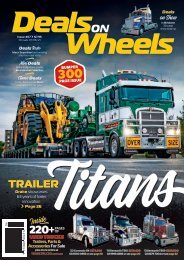Create successful ePaper yourself
Turn your PDF publications into a flip-book with our unique Google optimized e-Paper software.
HORTICULTURE<br />
remote control<br />
Perth-based Swan<br />
Systems uses Cloud-based<br />
technology to help farmers<br />
manage their water use,<br />
irrigation and crop health.<br />
By Lincoln Bertelli<br />
Above: Swan Systems says that water<br />
savings can be achieved from between<br />
20 to 30 per cent<br />
We built systems which<br />
helped us to take that data<br />
and turn it into meaningful<br />
day-to-day operational<br />
decisions.<br />
What started as a challenge during a consulting job for<br />
Rio Tinto has evolved into a company that beat global<br />
competition for an agricultural technology startup award last<br />
December.<br />
Founded in 2016, Swan’s origins can be traced further back to<br />
2010 when two of the eventual co-founders – Ivor Gaylard and<br />
Tim Hyde, whose backgrounds are in farming and consulting –<br />
were working with mining giant Rio Tinto on an environmentallysensitive<br />
job near Karijini National Park in Western Australia.<br />
“They needed to know seven days in advance, on any given<br />
day, how much water was going where,” says Gaylard, who is<br />
Swan’s chief operating officer and head of product development.<br />
“There were a lot of extra challenges over and above normal<br />
farming challenges.<br />
“We took our existing systems and ways of doing things and<br />
added an extra level on to that, so over a couple of years we<br />
built systems which enabled us to do that efficiently.<br />
“They had installed a lot of soil moisture sensors, flow meters<br />
[and] weather stations, and a lot of that data was coming<br />
through to our office.<br />
“We built systems which helped us to take that data and turn it<br />
into meaningful day-to-day operational decisions – working out<br />
the optimum amount of water to apply, the fertiliser program<br />
and doing all the reporting.”<br />
The success of this led to further interest from other parties<br />
and, in 2016, Gaylard and Hyde joined with Rod Campbell and<br />
formed Swan Systems to commercialise their product.<br />
“We basically took what was an in-house system and put it on<br />
the Cloud and made it scalable and suitable for any crop and<br />
any irrigation system,” says Gaylard.<br />
WINNING PITCH<br />
Swan – which stands for Scheduling Water and Nutrients – first<br />
took out the top honour in the Digital Innovation category at<br />
WA’s Innovator of the Year awards in 2018. It then won the<br />
global ag-tech category in Rabobank’s Foodbytes! Pitch awards<br />
for startups last year and was one of only two Australian<br />
companies named in a subsequent Rabobank report as<br />
‘startups to watch’ in 2021.<br />
So, for a software-based innovation, rather than a physical<br />
piece of farm equipment, how does it all work?<br />
“Swan is a decision-support system. It integrates with a lot<br />
of hardware but we don’t deal with hardware ourselves,” says<br />
Gaylard.<br />
“In a lot of cases, we can come in and the farmer has got<br />
some existing hardware and we just plug in to that. We bring<br />
their data in and help them make daily irrigation decisions<br />
– how much to irrigate, when to irrigate and manage their<br />
seasonal water use so they can do budgeting, planning for<br />
the season and then track their water use against that budget<br />
over the season.<br />
“We can help do fertiliser programs or bring in their own<br />
programs and then track what they’re actually doing against<br />
that program and allow them to manage that, and we bring in<br />
satellite imagery as well which they can use to keep an eye<br />
on the health of their fields and identify issues, particularly<br />
irrigation-related issues.<br />
“There are some directly measurable financial benefits. A lot of<br />
the time there are water savings and quite often in the region of<br />
20 to 30 per cent.<br />
“There are also yield increases by providing plants with<br />
optimum water and quality increases as well so the effect on a<br />
farmer’s bottom line is significant and measurable.<br />
“There are a whole lot of benefits that are harder to quantify<br />
like more efficient oversight of what’s going on, easier<br />
management and incorporating best practice in a systemised<br />
way so staff coming in and out can quickly pick up what’s<br />
going on.”<br />
46 Trade<strong>Farm</strong><strong>Machinery</strong>.com.au THE TRACTOR YOU WANT IS NOW EASIER TO FIND

















